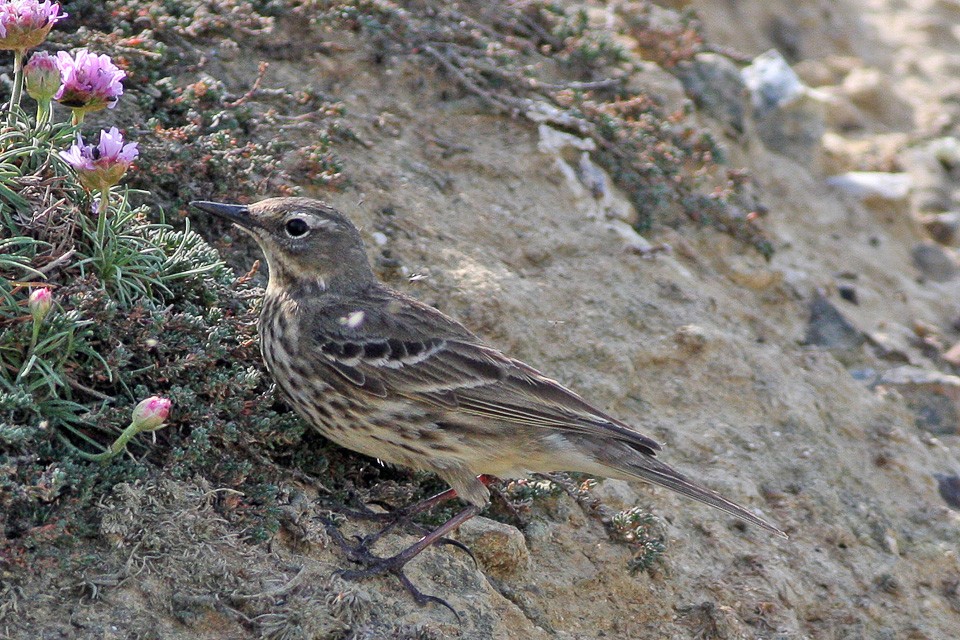Rock Pipit
A species of Pipits, Also known as Eurasian Rock Pipit Scientific name : Anthus petrosus Genus : Pipits
Rock Pipit, A species of Pipits
Also known as:
Eurasian Rock Pipit
Botanical name: Anthus petrosus
Genus: Pipits
Content
Description People often ask General Info
Description
The Eurasian rock pipit is 16.5–17 centimetres (6.5–6.7 in) long and weighs 18–32.5 grams (0.63–1.15 oz). The nominate race has smoky-olive upperparts, weakly streaked with darker brown, and buff underparts, heavily marked with poorly defined brown streaks. The legs, bill and iris are dark brown or blackish, and there is a pale eye-ring. The sexes are alike; although males average slightly brighter than females, the overlap is complete and birds cannot be sexed on appearance or measurements. Immature birds resemble the adult, although they may sometimes be browner and more streaked above, looking superficially similar to meadow pipits. Compared to the nominate form, A. p. kleinschmidti has slightly yellower, less olive, upperparts and brighter and yellower underparts between the breast streaking. A. p. littoralis may show pinkish underparts and a pale supercilium (eyebrow) in summer, thereby resembling the water pipit. Vagrant Eurasian rock pipits in winter are readily distinguishable from water pipits, but very difficult to assign to subspecies by appearance or measurements. The western populations are known to be nearly sedentary, so east of the Elbe basin vagrant Eurasian rock pipits are presumably mostly littoralis. Adult Eurasian rock pipits have a complete moult in August–September, at which time juveniles replace their body and some wing covert feathers, giving them an appearance very like the adults. From late January to early March there is a partial moult and individually variable moult of some body and wing covert feathers, and sometimes the central tail feathers. The Eurasian rock pipit is closely related to the water pipit and the meadow pipit, and is rather similar in appearance. Compared to the meadow pipit, the Eurasian rock pipit is darker, larger and longer-winged than its relative, and has dark, rather than pinkish-red, legs. The water pipit in winter plumage is also confusable with the Eurasian rock pipit, but has a strong supercilium and greyer upperparts; it is also typically much warier. The Eurasian rock pipit's dusky, rather than white, outer tail feathers are also a distinction from all its relatives. The habitats used by Eurasian rock and water pipits are completely separate in the breeding season, and there is little overlap even when birds are not nesting. The Eurasian rock pipit's song is a sequence of about twenty tinkling cheepa notes followed by a rising series of thin gee calls, and finishing with a short trill. The shrill pseep flight call is intermediate between the soft sip sip sip of the meadow pipit and the water pipit's short, thin fist. 
Size
17 cm
Colors
Brown
Yellow
Gray
Life Expectancy
9 years
Nest Placement
Ground
Feeding Habits
Rock Pipit primarily forages on rocky coasts for invertebrates, including snails, worms, small crustaceans, flies, and beetles. Adapting to available food sources, rock Pipit follows waves for prey and utilizes human activity to find hidden creatures. Seasonal and regional diets vary, sometimes including small fish or scavenged food. Rock Pipit faces minimal food competition due to distinct prey size preferences.
Habitat
Rock Pipit primarily resides in coastal areas, especially on rocky sea coasts and islands with minimal low vegetation, typically at elevations below 100 meters, though sometimes as high as 400 meters on isolated islands. Their habitat spans temperate and Arctic zones of Europe, predominantly along western and Baltic seashores. During winter and migration, they may move to inland waterfronts and occasionally sandy beaches.
Dite type
Insectivorous
General Info
Feeding Habits
Bird food type
Sounds
Call
Recording location: Belgium
Call
Recording location: Belgium
Behavior
The Eurasian rock pipit is a much more approachable bird than the water pipit. If startled, it flies a fairly short distance, close to the ground, before it alights, whereas its relative is warier and flies some distance before landing again. Eurasian rock pipits are usually solitary, only occasionally forming small flocks. 
Distribution Area
The Eurasian rock pipit is almost entirely coastal, frequenting rocky areas typically below 100 metres (330 ft), although on St Kilda it breeds at up to 400 metres (1,300 ft). The Eurasian rock pipit is not troubled by wind or rain, although it avoids very exposed situations. It may occur further inland in winter or on migration. The breeding range is temperate and Arctic Europe on western and Baltic Sea coasts, with a very small number sometimes nesting in Iceland. The nominate race is largely resident, with only limited movement. A. p. kleinschmidti, which nests on the Faroe Islands and the Scottish islands, may move to sandy beaches or inland to rivers and lakes in winter. A. p. littoralis is largely migratory, wintering on coasts from southern Scandinavia to southwest Europe, with a few reaching Morocco. Wanderers have reached Spitsbergen and the Canary Islands, but records in Europe away from the coast are rare. For example, a male shot at Dresden in 1894, now in the collection of the local State Museum of Zoology, is the sole specimen for Saxony. Migratory populations leave their breeding grounds in September and October, returning from March onwards, although in the far north they may not arrive before May. 
Species Status
Not globally threatened.
